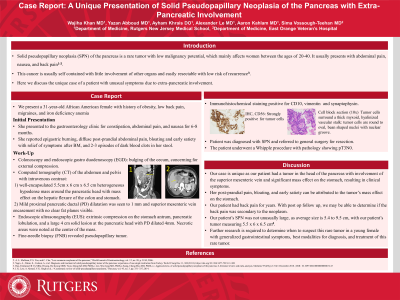Sunday Poster Session
Category: Biliary/Pancreas
P0111 - Case Report: A Unique Presentation of Solid Pseudopapillary Neoplasia of the Pancreas With Extra-Pancreatic Involvement
Sunday, October 22, 2023
3:30 PM - 7:00 PM PT
Location: Exhibit Hall

Has Audio

Wajiha Khan, MD
Rutgers New Jersey Medical School
Cartaret, NJ
Presenting Author(s)
Wajiha Khan, MD1, Yazan Abboud, MD1, Ayham Khrais, DO1, Alexander Le, MD1, Aaron Kahlam, MD1, Sima Vossough-Teehan, MD2
1Rutgers New Jersey Medical School, Newark, NJ; 2Veterans Affairs, Franklin lakes, NJ
Introduction: Solid pseudopapillary neoplasia (SPN) of the pancreas is a rare epithelial tumor with low malignancy potential, which mainly affects women between the ages of 20-40. It usually presents with abdominal pain, nausea, and back pain. These tumors generally have good outcomes with surgical resection and recurrence is rare. Here we discuss the unique case of a patient with unusual symptoms due to extra-pancreatic involvement.
Case Description/Methods: A 31-year-old African American female with history of obesity, low back pain, migraines, and iron deficiency anemia presented to the gastroenterology clinic for constipation, abdominal pain, and nausea for 6-8 months. She reported epigastric burning, diffuse post-prandial abdominal pain, bloating and early satiety with relief of symptoms after bowel movement, and 2-3 episodes of dark blood clots in her stool. Colonoscopy and endoscopic gastroduodenoscopy (EGD) showed bulging of the cecum, concerning for external compression. Computed tomography (CT) of the abdomen and pelvis with intravenous contrast revealed a well-encapsulated 5.5 cm x 6 cm x 6.5 cm heterogeneous hypodense mass around the pancreatic head with mass effect on the adjacent hepatic flexure of the colon in addition to the stomach. Mild proximal pancreatic ductal dilatation was seen to 1 mm and superior mesenteric vein encasement with no clear fat planes visible.
Endoscopic ultrasonography (EUS) revealed extrinsic compression on the stomach antrum, pancreatic lobulation, and a large 4 cm solid lesion at the pancreatic head with pancreatic duct (PD) dilated 4mm. Necrotic areas were noted at the center of the mass. Fine-needle biopsy (FNB) revealed pseudopapillary tumor. Immunohistochemical staining was positive for CD10, vimentin and synaptophysin. The patient underwent a Whipple procedure with pathology showing pT3N0.
Discussion: SPN is rare and can be suspected in a female between the ages of 20-40 with concern for pancreatic cancer. Prior case reports support more generalized symptoms, however we present a patient with manifestations of mass effect on colon, vasculature, and stomach. Further research is required to determine best modalities for diagnosis and treatment.

Disclosures:
Wajiha Khan, MD1, Yazan Abboud, MD1, Ayham Khrais, DO1, Alexander Le, MD1, Aaron Kahlam, MD1, Sima Vossough-Teehan, MD2. P0111 - Case Report: A Unique Presentation of Solid Pseudopapillary Neoplasia of the Pancreas With Extra-Pancreatic Involvement, ACG 2023 Annual Scientific Meeting Abstracts. Vancouver, BC, Canada: American College of Gastroenterology.
1Rutgers New Jersey Medical School, Newark, NJ; 2Veterans Affairs, Franklin lakes, NJ
Introduction: Solid pseudopapillary neoplasia (SPN) of the pancreas is a rare epithelial tumor with low malignancy potential, which mainly affects women between the ages of 20-40. It usually presents with abdominal pain, nausea, and back pain. These tumors generally have good outcomes with surgical resection and recurrence is rare. Here we discuss the unique case of a patient with unusual symptoms due to extra-pancreatic involvement.
Case Description/Methods: A 31-year-old African American female with history of obesity, low back pain, migraines, and iron deficiency anemia presented to the gastroenterology clinic for constipation, abdominal pain, and nausea for 6-8 months. She reported epigastric burning, diffuse post-prandial abdominal pain, bloating and early satiety with relief of symptoms after bowel movement, and 2-3 episodes of dark blood clots in her stool. Colonoscopy and endoscopic gastroduodenoscopy (EGD) showed bulging of the cecum, concerning for external compression. Computed tomography (CT) of the abdomen and pelvis with intravenous contrast revealed a well-encapsulated 5.5 cm x 6 cm x 6.5 cm heterogeneous hypodense mass around the pancreatic head with mass effect on the adjacent hepatic flexure of the colon in addition to the stomach. Mild proximal pancreatic ductal dilatation was seen to 1 mm and superior mesenteric vein encasement with no clear fat planes visible.
Endoscopic ultrasonography (EUS) revealed extrinsic compression on the stomach antrum, pancreatic lobulation, and a large 4 cm solid lesion at the pancreatic head with pancreatic duct (PD) dilated 4mm. Necrotic areas were noted at the center of the mass. Fine-needle biopsy (FNB) revealed pseudopapillary tumor. Immunohistochemical staining was positive for CD10, vimentin and synaptophysin. The patient underwent a Whipple procedure with pathology showing pT3N0.
Discussion: SPN is rare and can be suspected in a female between the ages of 20-40 with concern for pancreatic cancer. Prior case reports support more generalized symptoms, however we present a patient with manifestations of mass effect on colon, vasculature, and stomach. Further research is required to determine best modalities for diagnosis and treatment.

Figure: A) well-encapsulated 5.5cm x 6 cm x 6.5 cm heterogeneous hypodense mass around the pancreatic head with mass effect on the hepatic flexure of the colon and stomach.
B) Mild proximal pancreatic ductal (PD) dilatation was seen to 1 mm and superior mesenteric vein encasement with no clear fat planes visible.
C) IHC, CD56: Strongly positive for tumor cells
D)Cell block section (10x) Tumor cells surround a thick myxoid, hyalinized vascular stalk: tumor cells are round to oval, bean shaped nuclei with nuclear groove.
B) Mild proximal pancreatic ductal (PD) dilatation was seen to 1 mm and superior mesenteric vein encasement with no clear fat planes visible.
C) IHC, CD56: Strongly positive for tumor cells
D)Cell block section (10x) Tumor cells surround a thick myxoid, hyalinized vascular stalk: tumor cells are round to oval, bean shaped nuclei with nuclear groove.
Disclosures:
Wajiha Khan indicated no relevant financial relationships.
Yazan Abboud indicated no relevant financial relationships.
Ayham Khrais indicated no relevant financial relationships.
Alexander Le indicated no relevant financial relationships.
Aaron Kahlam indicated no relevant financial relationships.
Sima Vossough-Teehan indicated no relevant financial relationships.
Wajiha Khan, MD1, Yazan Abboud, MD1, Ayham Khrais, DO1, Alexander Le, MD1, Aaron Kahlam, MD1, Sima Vossough-Teehan, MD2. P0111 - Case Report: A Unique Presentation of Solid Pseudopapillary Neoplasia of the Pancreas With Extra-Pancreatic Involvement, ACG 2023 Annual Scientific Meeting Abstracts. Vancouver, BC, Canada: American College of Gastroenterology.

